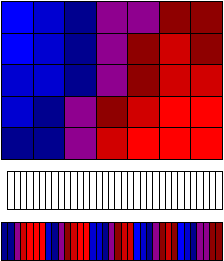 | ||
An implicit k-d tree is a k-d tree defined implicitly above a rectilinear grid. Its split planes' positions and orientations are not given explicitly but implicitly by some recursive splitting-function defined on the hyperrectangles belonging to the tree's nodes. Each inner node's split plane is positioned on a grid plane of the underlying grid, partitioning the node's grid into two subgrids.
Contents
Construction
Implicit k-d trees are in general not constructed explicitly. When accessing a node, its split plane orientation and position are evaluated using the specific splitting-function defining the tree. Different splitting-functions may result in different trees for the same underlying grid.
Splitting-functions
Splitting-functions may be adapted to special purposes. Underneath two specifications of special splitting-function classes.
A complete splitting function is for example the grid median splitting-function. It creates fairly balanced implicit k-d trees by using k-dimensional integer hyperrectangles hyprec[2][k] belonging to each node of the implicit k-d tree. The hyperrectangles define which gridcells of the rectilinear grid belong to their corresponding node. If the volume of this hyperrectangle equals one, the corresponding node is a single grid cell and is therefore not further subdivided and marked as leaf node. Otherwise the hyperrectangle's longest extend is chosen as orientation o. The corresponding split plane p is positioned onto the grid plane that is closest to the hyperrectangle's grid median along that orientation.
Split plane orientation o:
o = min{argmax(i = 1 ... k: (hyprec[1][i] - hyprec[0][i]))}Split plane position p:
p = roundDown((hyprec[0][o] + hyprec[1][o]) / 2)Assigning attributes to implicit k-d tree nodes
An obvious advantage of implicit k-d trees is that their split plane's orientations and positions need not to be stored explicitly.
But some applications require besides the split plane's orientations and positions further attributes at the inner tree nodes. These attributes may be for example single bits or single scalar values, defining if the subgrids belonging to the nodes are of interest or not. For complete implicit k-d trees it is possible to pre-allocate a correctly sized array of attributes and to assign each inner node of the tree to a unique element in that allocated array.
The amount of gridcells in the grid is equal the volume of the integer hyperrectangle belonging to the grid. As a complete implicit k-d tree has one inner node less than grid cells, it is known in advance how many attributes need to be stored. The relation "Volume of integer hyperrectangle to inner nodes" defines together with the complete splitting-function a recursive formula assigning to each split plane a unique element in the allocated array. The corresponding algorithm is given in C-pseudo code underneath.
It is worth mentioning that this algorithm works for all rectilinear grids. The corresponding integer hyperrectangle does not necessarily have to have sidelengths that are powers of two.
Applications
Implicit max-k-d trees are used for ray casting isosurfaces/MIP (maximum intensity projection). The attribute assigned to each inner node is the maximal scalar value given in the subgrid belonging to the node. Nodes are not traversed if their scalar values are smaller than the searched iso-value/current maximum intensity along the ray. The low storage requirements of the implicit max kd-tree and the favorable visualization complexity of ray casting allow to ray cast (and even change the isosurface for) very large scalar fields at interactive framerates on commodity PCs. Similarly an implicit min/max kd-tree may be used to efficiently evaluate queries such as terrain line of sight.
Complexity
Given an implicit k-d tree spanned over an k-dimensional grid with n gridcells.
